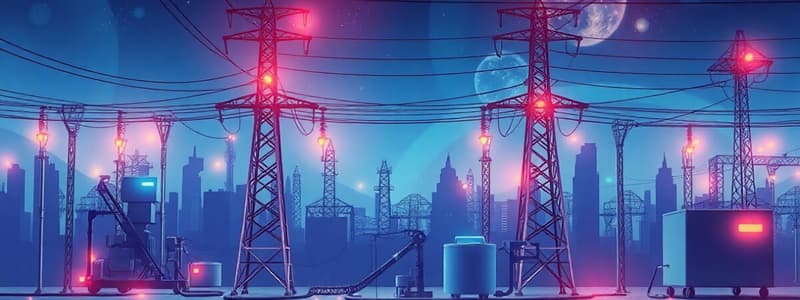Podcast
Questions and Answers
What voltage is typically measured between two hot wires in a three-phase commercial system?
What voltage is typically measured between two hot wires in a three-phase commercial system?
- 400V
- 277V
- 120V
- 208V or 480V (correct)
Which of the following is a benefit of three-phase power?
Which of the following is a benefit of three-phase power?
- Improved efficiency (correct)
- Lower installation costs for large appliances
- Less equipment needed for distribution
- Higher power capacity (correct)
What is the phase angle difference between each phase in a three-phase system?
What is the phase angle difference between each phase in a three-phase system?
- 60 degrees
- 90 degrees
- 120 degrees (correct)
- 180 degrees
How many hot wires are present in a three-phase system?
How many hot wires are present in a three-phase system?
What does the presence of three large wires entering the main panel typically indicate?
What does the presence of three large wires entering the main panel typically indicate?
What is a primary benefit of three-phase power in commercial applications?
What is a primary benefit of three-phase power in commercial applications?
How does three-phase power contribute to cost savings over time?
How does three-phase power contribute to cost savings over time?
Which commercial building is most likely to benefit from the stability of three-phase power?
Which commercial building is most likely to benefit from the stability of three-phase power?
What advantage does three-phase power provide in terms of equipment operation?
What advantage does three-phase power provide in terms of equipment operation?
What is a practical benefit of using three-phase power systems?
What is a practical benefit of using three-phase power systems?
What level of efficiency does three-phase power provide compared to single-phase systems?
What level of efficiency does three-phase power provide compared to single-phase systems?
How does three-phase power enhance versatility in electrical systems?
How does three-phase power enhance versatility in electrical systems?
Why is three-phase power critical for data centers?
Why is three-phase power critical for data centers?
Which of the following is a primary benefit of three-phase systems for businesses?
Which of the following is a primary benefit of three-phase systems for businesses?
What is the nominal voltage that three-phase equipment is designed to operate at?
What is the nominal voltage that three-phase equipment is designed to operate at?
In which industry is three-phase power particularly critical for powering heavy machinery?
In which industry is three-phase power particularly critical for powering heavy machinery?
What advantage does three-phase power offer for grid stability?
What advantage does three-phase power offer for grid stability?
How does three-phase power improve energy management in commercial solar installations?
How does three-phase power improve energy management in commercial solar installations?
What is a common disadvantage of operating a single-phase system compared to a three-phase system?
What is a common disadvantage of operating a single-phase system compared to a three-phase system?
What happens to the voltage at the equipment end in a three-phase power system?
What happens to the voltage at the equipment end in a three-phase power system?
Which of the following voltages is NOT typically used in three-phase systems in the US?
Which of the following voltages is NOT typically used in three-phase systems in the US?
Why might a commercial solar installation require three-phase power connections?
Why might a commercial solar installation require three-phase power connections?
How can businesses effectively communicate the value of three-phase power based on its features?
How can businesses effectively communicate the value of three-phase power based on its features?
What indicates the presence of a three-phase power connection during site visits?
What indicates the presence of a three-phase power connection during site visits?
What is one significant long-term benefit of using three-phase systems despite higher initial costs?
What is one significant long-term benefit of using three-phase systems despite higher initial costs?
Which of the following best describes the efficiency of three-phase power compared to single-phase systems?
Which of the following best describes the efficiency of three-phase power compared to single-phase systems?
Flashcards
High Power Capacity
High Power Capacity
Three-phase power delivers more electricity than single-phase systems, making it ideal for businesses with high energy demands.
Improved Efficiency
Improved Efficiency
Three-phase power provides stable and consistent energy, reducing energy waste and saving money.
Cost Savings
Cost Savings
While the initial cost of setting up three-phase power is higher, long-term savings are achieved due to lower energy bills and maintenance costs.
Versatility
Versatility
Signup and view all the flashcards
Smoother Operation
Smoother Operation
Signup and view all the flashcards
Reduced Equipment Size
Reduced Equipment Size
Signup and view all the flashcards
Longer Equipment Lifespan
Longer Equipment Lifespan
Signup and view all the flashcards
Who Needs Three-Phase Power?
Who Needs Three-Phase Power?
Signup and view all the flashcards
Three-phase Power
Three-phase Power
Signup and view all the flashcards
Distribution Voltage
Distribution Voltage
Signup and view all the flashcards
Utilization Voltage
Utilization Voltage
Signup and view all the flashcards
Scalability
Scalability
Signup and view all the flashcards
208V
208V
Signup and view all the flashcards
Manufacturing
Manufacturing
Signup and view all the flashcards
Data Centers
Data Centers
Signup and view all the flashcards
Healthcare
Healthcare
Signup and view all the flashcards
Retail & Warehousing
Retail & Warehousing
Signup and view all the flashcards
Agriculture
Agriculture
Signup and view all the flashcards
Three-phase Solar Inverters
Three-phase Solar Inverters
Signup and view all the flashcards
Grid Integration
Grid Integration
Signup and view all the flashcards
Scalability
Scalability
Signup and view all the flashcards
Energy Management
Energy Management
Signup and view all the flashcards
Compliance and Regulations
Compliance and Regulations
Signup and view all the flashcards
Three-phase power system
Three-phase power system
Signup and view all the flashcards
Voltage between two hot wires
Voltage between two hot wires
Signup and view all the flashcards
Voltage between hot and neutral
Voltage between hot and neutral
Signup and view all the flashcards
Identifying three-phase power
Identifying three-phase power
Signup and view all the flashcards
Three-phase for large AC
Three-phase for large AC
Signup and view all the flashcards
Study Notes
Three-Phase Power for Sales Representatives
- Three-phase power is a distribution system using three alternating currents offset by 120 degrees.
- It's efficient, handling higher power loads, critical for commercial and industrial use.
Benefits for Commercial Customers
- Higher Power Capacity: Three-phase delivers more power than single-phase, crucial for high-demand businesses with heavy equipment.
- Improved Efficiency: Provides stable, efficient power, reducing energy costs and environmental impact.
- Cost Savings: Despite higher initial cost, three-phase offers long-term savings via decreased energy use and maintenance.
- Versatility: Allows for single-phase power provision when needed.
Ideal Applications
- Medical Hospitals: Reliable power for critical medical equipment and high demands.
- Data Centers: Supports servers, networks, and cooling systems requiring substantial capacity and stability.
- Schools: Provides capacity and reliability for labs, auditoriums, and HVAC.
- Grocery Stores: Handles large refrigeration, lighting, and other equipment for smooth operation.
- Hotels: Meets higher capacity and stability demands for multiple rooms, amenities, and HVAC.
Practical Advantages
- Smoother Operation: Constant, uninterrupted power supply suitable for sensitive equipment and continuous operations.
- Reduced Equipment Size: Three-phase motors are often smaller and less expensive than single-phase equivalents.
- Longer Equipment Lifespan: Reduced vibration in three-phase motors minimizes wear and tear.
- Scalability: Easier to adapt to growing power demands without extensive infrastructure changes.
Industry Applications
- Manufacturing: Powers heavy machinery, conveyor belts, and industrial heating.
- Data Centers: Supports servers, networking, and cooling needs.
- Healthcare: Powers critical medical equipment and hospital HVAC.
- Retail and Warehousing: Enables smooth operations in large facilities.
- Agriculture: Powers irrigation and farm equipment.
Voltage Considerations
- Distribution Voltage: 480V is common, but voltage drops occur during transmission.
- Utilization Voltage: Actual voltage at the equipment end is usually 460V.
- Operating Voltage: Three-phase equipment operates at 460V, with a 20V tolerance (440V-480V).
- Other Voltages: 208V and 240V are also used in commercial settings.
Three-Phase and Commercial Solar Installations
- Power Capacity and Efficiency: Ideal for commercial solar due to high power handling capabilities.
- Supports large machinery, extensive HVAC, elevators, and rapid EV charging.
- Grid Integration and Stability: Enhanced grid stability, reduced voltage risks.
- Scalability and Cost-Effectiveness: Easier scalability, accommodates larger inverter capacities (up to 30 kW).
- Energy Management and Monitoring: Real-time performance monitoring, optimized energy harvest via MPPT algorithms.
Compliance and Regulations
- Grid codes often mandate 3-phase inverters for large solar installations.
Determining Three-Phase Connections
- Site Visits: Locate the electrical panel, check the main breaker (three joined switches).
- Hot Wires: Count the hot wires (three indicates three-phase).
- Labels and Large Equipment: Look for labels ("Three-Phase") and presence of large machinery.
- Voltage Measurement: (Trained personnel only) Measure between hot wires (~208V/480V) and hot/neutral (~120V/277V).
Quiz Questions and Answers
- Phase Angle: 120 degrees between phases.
- Efficiency: Three-phase is more efficient for large commercial use.
- Hot Wires: Three hot wires typically.
- Common Voltage: 208V or 480V between hot wires.
- Inappropriate Cost Comparison: Initial costs for 3-phase are higher.
- Main Breaker Switches: Three switches joined together.
- HVAC Indication: Large HVAC systems likely indicate three-phase power.
- Neutral Voltage: 120V typical in 208V three-phase.
- Site Visit Indicator: Three large wires entering the panel.
- Universal Need: Three-phase power is not needed for every commercial building.
Studying That Suits You
Use AI to generate personalized quizzes and flashcards to suit your learning preferences.




